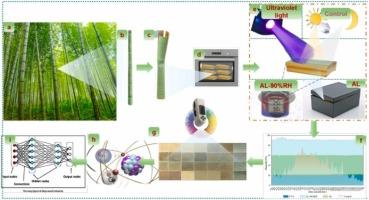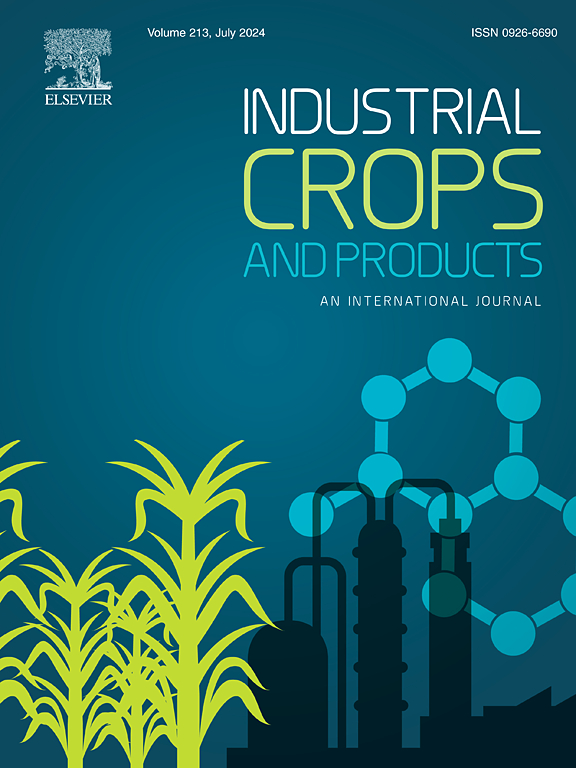Investigating the photodegradation-induced visual degradation and its underlying mechanisms of warehousing bamboo
IF 5.6
1区 农林科学
Q1 AGRICULTURAL ENGINEERING
引用次数: 0
Abstract
Bamboo is a sustainable and environment-friendly polymer. In order to investigate the effect of photoaging on the service-life of bamboo, ultraviolet aging (UV-aging), light-avoidance −90 %RH (AL-90 %RH), light-avoidance (AL) and control were continuously monitored for 26 weeks under four kinds of light conditions. The surface color, micro-morphology and surface interfacial composition of comparing various bamboo samples during storage. The results showed that the total color difference for the cortex (9.758 ± 0.712) and pith (1.325 ± 0.075) under AL conditions were lower than the other three sets of storage conditions, and L* values were reduced by 56.42 % and 53.73 %, respectively. In addition, microflora and grooves were formed on the surface of bamboo stored under AL-90 %RH conditions. Meanwhile, catheters were the main channels for the propagation of mycelium in bamboo. Moreover, the Cox/unox value (an oxygenated to unoxygenated carbon ratio of 0.964) increased sharply under these conditions. UV-aging destroyed the texture and structure of bamboo tissue cells and surfaces, degraded the surface lignin content by 18.89 %, and exposed more observable hemicellulose and cellulose functional groups, thus increasing the carbon binding energy and becoming more difficult to degrade. Finally, the Long Short-Term Memory (LSTM) neural network model was used to predict the fading of the surface color and the volatile compounds after aging, and different photoaging color indication systems were established. Exploring the aging mechanism of bamboo during storage is important for promoting the development of bamboo industry and replacing plastic products, and helping in determine the practical applications of the proposed strategies, their economic benefits and limiting of bamboo photodegradation under optimal warehousing conditions. This meet the current requirements of sustainable development by preserving bamboo resources and use instead renewable resources for both environmental and economic benefit.

仓储竹光降解致视觉退化及其机制的研究
竹子是一种可持续发展的环保聚合物。为了研究光老化对竹材使用寿命的影响,在4种光照条件下连续监测了紫外光老化(UV-aging)、避光−90 %RH (AL-90 %RH)、避光(AL)和对照26周。比较不同竹材样品在贮藏过程中的表面颜色、微观形貌和表面界面组成。结果表明,AL条件下的皮层总色差(9.758 ± 0.712)和髓总色差(1.325 ± 0.075)均低于其他3组贮藏条件,L* 值分别降低了56.42 %和53.73 %。在AL-90 %RH条件下,竹材表面形成了微生物区系和沟槽。同时,导管是竹材中菌丝繁殖的主要通道。此外,在这些条件下,Cox/unox值(含氧碳与无氧碳之比为0.964)急剧增加。紫外线老化破坏了竹材组织细胞和表面的质地和结构,使表面木质素含量降低18.89 %,暴露出更多可观察到的半纤维素和纤维素官能团,使碳结合能增加,降解难度加大。最后,利用长短期记忆(LSTM)神经网络模型预测老化后表面颜色和挥发性化合物的褪色,并建立不同的光老化颜色指示系统。研究竹材在贮藏过程中的老化机理,对于促进竹材产业的发展和替代塑料制品具有重要意义,有助于确定所提出的贮藏策略的实际应用、经济效益和最佳贮藏条件下竹材光降解的限制。保护竹材资源,利用可再生资源,以满足当前可持续发展的要求,兼顾环境效益和经济效益。
本文章由计算机程序翻译,如有差异,请以英文原文为准。
求助全文
约1分钟内获得全文
求助全文
来源期刊

Industrial Crops and Products
农林科学-农业工程
CiteScore
9.50
自引率
8.50%
发文量
1518
审稿时长
43 days
期刊介绍:
Industrial Crops and Products is an International Journal publishing academic and industrial research on industrial (defined as non-food/non-feed) crops and products. Papers concern both crop-oriented and bio-based materials from crops-oriented research, and should be of interest to an international audience, hypothesis driven, and where comparisons are made statistics performed.
文献相关原料
公司名称
产品信息
阿拉丁
potassium bromide
阿拉丁
potassium bromide
 求助内容:
求助内容: 应助结果提醒方式:
应助结果提醒方式:


